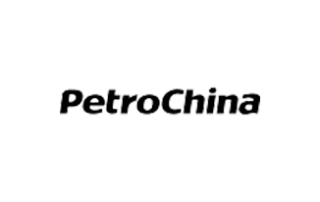services for you
Drilling/Cutting/Bending/Beveled/Threading/Decoiling/Galvanizing/Spraying/Sheet Forming/Extrusion/Stamping/Forging/Machining, etc.
Super production and processing services
customized steel products for you
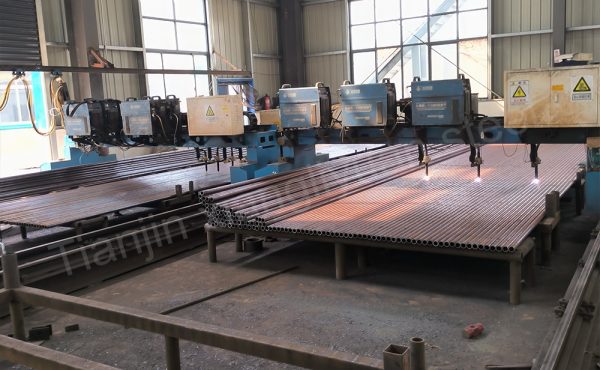
Steel pipe drilling refers to the process of perforating or drilling holes in steel pipes. Such as drilling machines, punching machines, etc.
Common steel pipe drilling categories include:
Round hole: It is one of the most common forms of steel pipe drilling. Circular holes can be formed on the steel pipe by drilling or punching equipment. This hole shape is suitable for many applications such as vents, drainage holes, etc.
Square hole: refers to the processing method of forming square holes in steel pipes. Square holes are usually suitable for specific design needs, such as installing ventilation nets, guardrails, etc.
Oval hole: It is an oval-shaped hole that can be processed by special equipment or technology. Oval holes are more common in some decorative applications or specially designed steel pipe products.
Special-shaped holes: refers to holes with non-traditional shapes, such as star-shaped holes, heart-shaped holes, etc. These holes are usually used for decorative designs or special purposes.
The main uses of steel pipe drilling include:
Ventilation and Drainage: In ductwork or specific equipment, drilling holes can help provide ventilation and drainage to keep the system functioning properly.
Decorative design: In fields such as construction and furniture, drilling can add decorative effects to steel pipe products, giving them more design possibilities and aesthetics.
Weight reduction: In some applications where the weight of the steel pipe needs to be reduced, drilling can reduce the weight of the steel pipe and improve its convenience and economy.
Functional requirements: Some special applications may require holes of specific shapes or sizes to be formed on steel pipes to meet functional requirements, such as sensor installation, pipe connections, etc.
Steel pipe drilling is a common steel pipe processing method with various classifications and uses. We can choose the appropriate processing method according to your specific needs and applications.
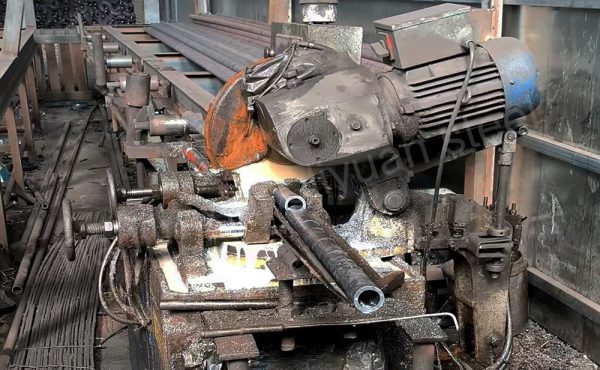
Steel pipe cutting refers to the process of cutting or cutting off steel pipes, such as sawing, flame cutting, plasma cutting, etc. Steel pipe cutting usually involves selecting the appropriate cutting method based on specific needs and applications.
Common steel pipe cutting categories include:
Mechanical cutting: Mechanical cutting usually uses equipment such as saws and cutting machines to cut steel pipes by rotating saw blades or cutting knives. Mechanical cutting is generally suitable for straight cuts, allowing for efficient, precise cuts.
Thermal Cutting: Thermal cutting refers to the cutting of steel pipes using flame or plasma cutting equipment. Flame cutting uses a flame that injects oxygen and fuel to heat and cut the steel pipe, while plasma cutting cuts through a high-temperature plasma arc. Thermal cutting is suitable for cutting all kinds of steel pipes, including thicker steel pipes and large-diameter steel pipes.
Cold cutting: Cold cutting refers to cutting steel pipes at room temperature, usually using a cold saw or other cold cutting equipment. Cold cutting can reduce thermal deformation and deterioration, and is suitable for steel pipes that require higher cutting quality and surface quality.
Electron beam cutting: Electron beam cutting is a high-precision cutting method that cuts steel pipes through the focusing and control of electron beams. Electron beam cutting is suitable for steel pipes that require high cutting accuracy, such as aerospace, automobile manufacturing and other fields.
The main uses of steel pipe cutting include:
Cutting to length: cutting long steel pipes into steel pipes of specified lengths to meet specific size requirements and facilitate transportation, storage and use.
Processing and manufacturing: cutting steel pipes into parts of specific shapes or sizes for manufacturing machinery, equipment, components, etc.
Pipe connection: In pipeline engineering, pipes are connected, spliced and repaired by cutting steel pipes.
Steel pipe cutting is an important part of steel pipe processing and has a variety of classifications and uses. We can provide processing services according to your specific needs.
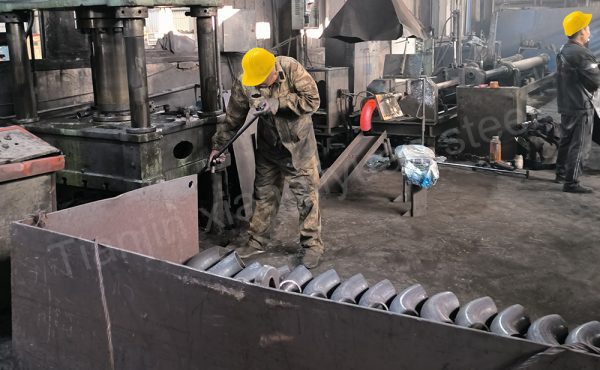 Steel pipe bending refers to bending steel pipes into the required shape through processing methods to meet specific design and application needs. This processing method can change the direction and angle of the pipe without changing the cross-sectional area of the pipe.
Steel pipe bending refers to bending steel pipes into the required shape through processing methods to meet specific design and application needs. This processing method can change the direction and angle of the pipe without changing the cross-sectional area of the pipe.
Processing technology:
Cold bending: Cold bending is a method of bending pipes at room temperature. Steel pipes are usually bent into the desired shape using a pipe bending machine or bending die. This method is suitable for general steel pipes and smaller diameter pipes.
Hot pipe bending: Hot pipe bending is a method of bending pipes at high temperatures. By heating the steel pipe, it becomes soft and forms the desired shape during the bending process. This method is suitable for steel pipes with larger diameters and thicker wall thicknesses.
use:
Pipe layout: In the pipeline system, steel pipe bends can change the direction and angle of the pipeline, achieve reasonable design of pipeline layout, and improve the efficiency and performance of the pipeline system.
Pipe connection: Steel pipe elbows are used to connect different components in the pipeline system, such as elbows, curved sections, etc., to adapt to complex pipeline layout and connection needs.
Building structures: In building structures, steel pipe bends are used to manufacture structural components of various shapes and angles, such as curved beams, curved columns, etc.
Decorative design: In decorative design, steel pipe bends can be used to manufacture decorative parts of various shapes, such as curved railings, curved handrails, etc., to add to the beauty and artistry of the building.
Steel pipe bending is a common steel pipe processing method with various classifications and uses. We can provide processing services according to your specific needs.
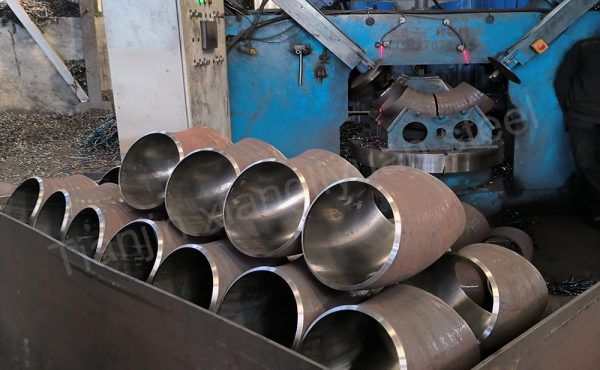 Steel pipe Beveled refers to beveling or other special shapes at the end of the steel pipe.
Steel pipe Beveled refers to beveling or other special shapes at the end of the steel pipe.
The bevel processing methods include the following:
V-groove: V-groove is a common form of groove, usually used for butt welding. The two sides of the V-shaped groove are V-shaped, which helps to evenly distribute the welding filler material during welding and improve the welding quality.
U-groove: U-groove is also a common form of groove, similar to V-groove, but the shape of both sides is U-shaped. U-shaped grooves are usually used for butt welding, and their advantage is that the consumption of welding filler material is relatively small.
Flat-groove: Flat-groove means that the end of the steel pipe is cut horizontally or obliquely to form a flat end face. Flat bevels are typically used for butt welding, but may consume more filler material than V- or U-bevels.
J-groove: J-groove is a special form of groove, its shape is similar to the letter “J”. J-groove is usually used for butt welding, but compared to V- or U-groove, J-groove can provide better welding angle and distribution of filler material.
Y-groove: Y-groove is a rare form of groove, its shape is similar to the letter “Y”. Y-shaped grooves are usually used for special welding needs, such as certain special-shaped pipe connections.
Main uses include:
Welding connection: The steel pipe groove can provide a better contact surface and welding angle for welding to ensure welding quality. In pipework and structural engineering, steel pipes are often beveled for welding connections to ensure a secure and airtight connection.
Pipe fitting manufacturing: When manufacturing steel pipe fittings, it is usually necessary to bevel the pipe ends to facilitate connection with other pipe fittings or equipment. For example, in pipeline systems, various elbows, flanges, joints and other pipe fittings usually require bevel processing to ensure the firmness and sealing of the connection.
Pipeline construction: At the pipeline construction site, in order to adapt to the layout, connection and installation of the pipeline, the steel pipe may need to be beveled. Beveled can make pipe connection and layout more flexible and convenient.
Reduce stress concentration: By Beveled the steel pipe, the stress concentration at the pipe connection can be reduced and the pressure resistance and safety of the pipe can be improved.
Steel pipe Beveled plays a very important role in the process of steel pipe connection, manufacturing and construction. It can improve the quality and efficiency of connections and ensure the normal operation and safe use of the pipeline system.
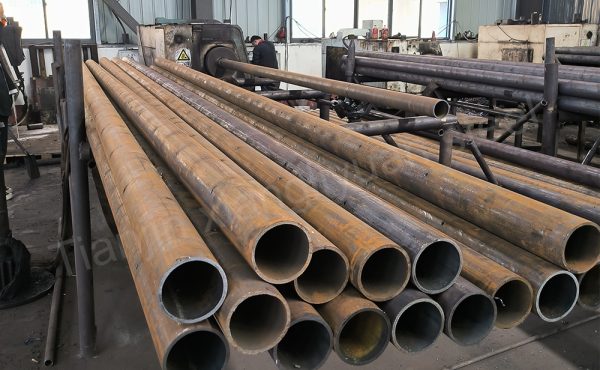 In some specific occasions, steel pipes need to be threaded to connect other parts or components.
In some specific occasions, steel pipes need to be threaded to connect other parts or components.
Before processing, it is necessary to clarify the specifications of the threads to be engraved on the steel pipe, including the diameter, pitch and other parameters of the threads. The steel pipe is fixed on the threading machine tool and fixed using clamps to ensure the stability and accuracy of the steel pipe during processing. According to the specifications of the threading tool and the requirements of the steel pipe, the parameters of the threading machine tool are adjusted, including the feed speed of the tool, spindle speed, cutting depth and other parameters, to ensure the processing effect and quality. Before threading, cutting oil needs to be evenly applied on the surface of the steel pipe to reduce friction and heat during the cutting process and to protect the tool. Then, according to the preset parameters and requirements, the thread is cut to ensure good contact between the tool and the steel pipe surface, while ensuring stability and safety during the cutting process.
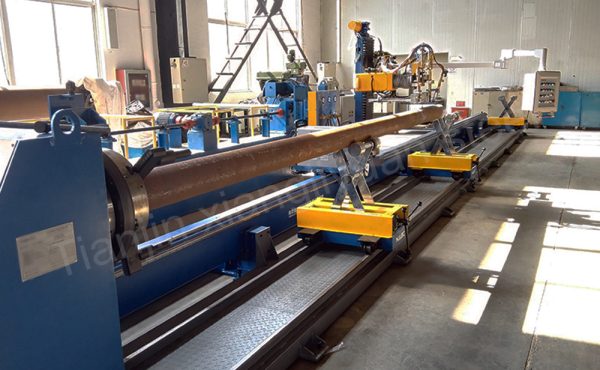 Steel pipe slotting refers to the process of cutting channels or grooves on the surface of steel pipes. This process requires the use of machines such as cutting machines and steel pipe slotting machines.
Steel pipe slotting refers to the process of cutting channels or grooves on the surface of steel pipes. This process requires the use of machines such as cutting machines and steel pipe slotting machines.
Common steel pipe slotting classifications include:
Single Side slotting: Channels or grooves cut into one side of a steel pipe, usually for specific pipe layout and connection needs.
Double-Sided slotting: Channels or grooves cut into both sides of a steel pipe, often used for connections, splicing or installation in piping systems.
Circular slotting: Cutting channels or grooves around the steel pipe, usually used to install pipe supports, clamps, etc.
Longitudinal slotting: Cutting channels or grooves along the longitudinal direction of steel pipe, usually for specific pipe connection or installation needs.
use:
Pipe connections: slotting in steel pipes can facilitate pipe connections, such as in piping systems, by allowing pipes to be connected or disconnected more easily.
Pipe supports: Slotted steel pipes can be used to manufacture pipe supports, which provide support and fixation of the piping system.
Anti-slip treatment: In specific applications, such as industrial equipment or platforms, steel pipe slotting can increase surface friction and play an anti-slip role.
Ventilation and drainage: In some specific pipeline systems, ventilation and drainage functions can be achieved through steel pipe slotting to maintain the normal operation of the system.
Decorative design: In construction or interior decoration, steel pipe slotting can provide designers with more creative space to create unique decorative effects.
Steel pipe slotting is a common steel pipe processing method with various classifications and uses. We can provide corresponding processing services according to your specific needs.
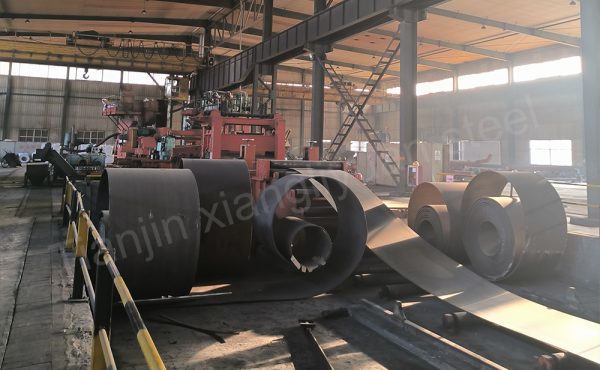 Steel coil Decoiling refers to the process of unwinding or uncoiling coiled steel (usually steel coils). Steel coils usually come from the factory in coils, which takes up less space during storage and transportation. However, in actual use, the steel coil needs to be unrolled for further processing or manufacturing. This process is usually completed by a steel coil Decoiler, where the steel coil is placed on the equipment, and then the steel coil is unwound and straightened into a flat steel plate or steel strip for subsequent processing or use.
Steel coil Decoiling refers to the process of unwinding or uncoiling coiled steel (usually steel coils). Steel coils usually come from the factory in coils, which takes up less space during storage and transportation. However, in actual use, the steel coil needs to be unrolled for further processing or manufacturing. This process is usually completed by a steel coil Decoiler, where the steel coil is placed on the equipment, and then the steel coil is unwound and straightened into a flat steel plate or steel strip for subsequent processing or use.
The main purpose of decoiling steel coils is to facilitate subsequent processing and use. Some common uses include:
Processing and manufacturing: After Decoiling the steel coil, it can be processed by cutting, stamping, welding and other processing techniques, and is used to manufacture various products such as automobile parts, building structures, home appliances, and containers.
Building structure: Unfolded steel plates can be used in the manufacture of building structures, such as stairs, floors, roofs, etc.
Welding: Unrolled steel strips or plates can be used to weld into large structures such as bridges, pipelines, etc.
Manufacturing pipes: The unfolded steel strips can be processed into pipes of various specifications and shapes through plate rolling machines or pipe welding machines, which are used in fields such as transporting liquids or gases, building structures, etc.
Cold rolling, hot rolling: Unrolled steel coils can be cold rolled or hot rolled to change the properties and shape of the steel to meet the needs of different industrial fields, etc.
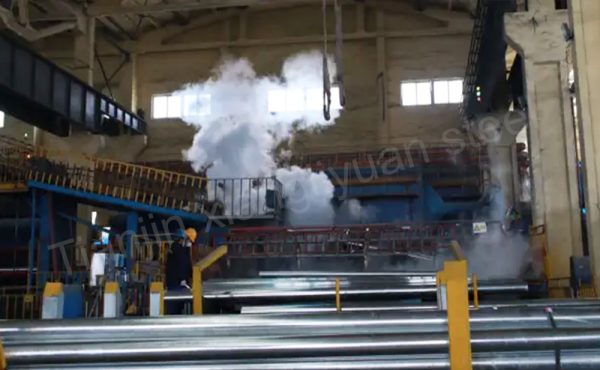 Galvanizing steel is an anti-corrosion processing method that protects steel from oxidation and corrosion by coating the surface with a layer of zinc.
Galvanizing steel is an anti-corrosion processing method that protects steel from oxidation and corrosion by coating the surface with a layer of zinc.
The steel galvanizing process is usually divided into two main types: hot dip galvanizing and electro galvanizing.
Hot dip galvanizing:
Process: The steel is immersed in the molten zinc liquid, so that the zinc liquid reacts with the surface of the steel to form a zinc layer.
Classification: According to different treatment methods, it can be divided into hot-dip ordinary galvanizing and hot-dip aluminum-zinc alloy plating.
Purpose: Suitable for steel materials that require high corrosion resistance, such as building structures, pipes, auto parts, etc.
Electro-galvanized:
Process: A layer of zinc is electrochemically plated on the steel surface.
Classification: According to different processing methods and electroplating equipment, it can be divided into acid electroplating zinc, alkaline electroplating zinc, etc.
Usage: Suitable for steel products with high requirements on surface finish and appearance, such as hardware products, furniture, electrical components, etc.
The main uses of galvanized steel:
Anti-corrosion: The galvanized layer can effectively block the contact between the steel surface and the external environment, extending the service life of the steel, and is especially suitable for use in humid and corrosive environments.
Beautiful: The surface of galvanized steel has a metallic luster and a more beautiful appearance. It is suitable for manufacturing products that require beautiful appearance.
Wear resistance: The galvanized layer can improve the wear resistance and corrosion resistance of steel, making the steel more durable.
Electrical conductivity: The galvanized layer has good electrical conductivity and is suitable for some applications that require electrical conductivity.
Galvanizing steel is a commonly used surface treatment method that can improve the corrosion resistance, aesthetics and durability of steel. It is widely used in construction, industry, furniture and other fields.
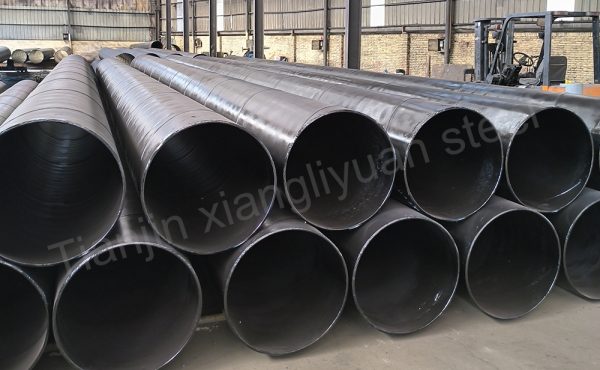 Steel spray painting is a common surface treatment method. It forms a protective film on the surface of steel by spraying paint to improve the anti-corrosion performance, aesthetics and durability of steel. The process of painting steel includes steps such as surface preparation, application and curing.
Steel spray painting is a common surface treatment method. It forms a protective film on the surface of steel by spraying paint to improve the anti-corrosion performance, aesthetics and durability of steel. The process of painting steel includes steps such as surface preparation, application and curing.
Processing steps:
Surface preparation: Treat the steel surface, including removing rust, oil, dust, etc., and perform surface cleaning and polishing to ensure coating adhesion and coating effect.
Primer coating: Spray a layer of primer on the steel surface to improve surface adhesion, anti-corrosion performance and coating uniformity.
Topcoat application: After the primer is applied, a layer of topcoat is sprayed, usually a colored paint, to improve the aesthetics and decorative effect of the steel.
Curing: The sprayed steel is cured, usually through natural drying or baking, so that the coating forms a stable protective film.
Classification:
Spraying method: It can be divided into two methods: manual spraying and automatic spraying. Choose the appropriate spraying method according to the processing scale and requirements.
Coating type: According to the type and composition of coating, it can be divided into paint, coating, glue and other types.
use:
Anti-corrosion: The sprayed coating can effectively isolate the steel surface from contact with the external environment, improve the anti-corrosion performance of the steel, and extend the service life.
Beautiful: The sprayed coating can provide rich color choices and decorative effects, giving the steel a better appearance and decorative effect.
Wear resistance: The sprayed coating can improve the wear resistance and weather resistance of the steel and protect the steel from the influence of the external environment.
Marking: Sprayed paint can be used to mark product information, logos, etc. on the surface of steel to facilitate identification and management.
Steel spray painting is a common surface treatment method with various classifications and uses. We can provide corresponding processing services according to your specific needs.
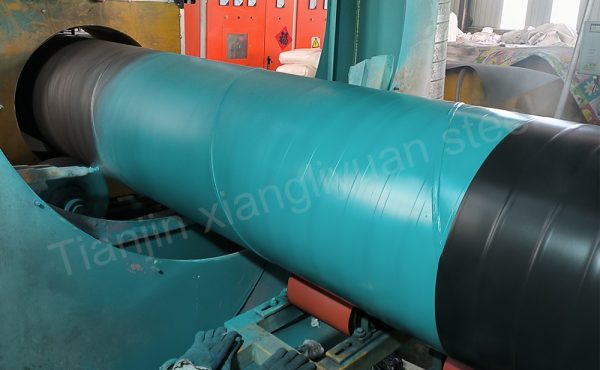 Steel powder coating is a common surface treatment method that sprays powder coating on the steel surface and then solidifies it to form a strong protective film. This method is similar to spray painting, but uses powdered paint instead of liquid paint.
Steel powder coating is a common surface treatment method that sprays powder coating on the steel surface and then solidifies it to form a strong protective film. This method is similar to spray painting, but uses powdered paint instead of liquid paint.
The processing technology of steel powder coating includes surface preparation, powder coating, curing and other steps.
Surface preparation: Treat the steel surface, including cleaning, removing rust, oil, dust, etc., to ensure the surface is smooth and clean, and to improve the adhesion of the powder coating.
Powder coating: The powder coating is evenly applied on the steel surface by electrostatic spraying or spray gun spraying to form a uniform coating.
Curing: The sprayed steel is cured, usually by baking or heat curing, so that the powder coating forms a strong protective film.
Classification:
Classification by powder type: According to the composition and properties of the powder, it can be divided into epoxy resin powder, polyester powder, polyethylene powder, etc.
Classification by spraying method: It can be divided into two methods: manual powder spraying and automatic powder spraying. Choose the appropriate spraying method according to the processing scale and requirements.
use:
Anti-corrosion: Powder spray coating can effectively isolate the steel surface from contact with the external environment, improve the anti-corrosion performance of the steel, and extend the service life.
Beautiful: The powder-coated coating can provide rich color choices and decorative effects, giving the steel a better appearance and decorative effect.
Wear resistance: The powder-coated coating can improve the wear resistance and weather resistance of the steel and protect the steel from the influence of the external environment.
Environmental protection: Compared with liquid coatings, powder coatings do not evaporate organic solvents during the construction process and are environmentally friendly.
Energy saving: Powder coating has high efficiency and high uniformity, which can reduce coating time and paint waste, saving energy and costs.
Powder spraying of steel is a common surface treatment method with many classifications and uses. We can provide corresponding processing services and powder types according to your specific needs.
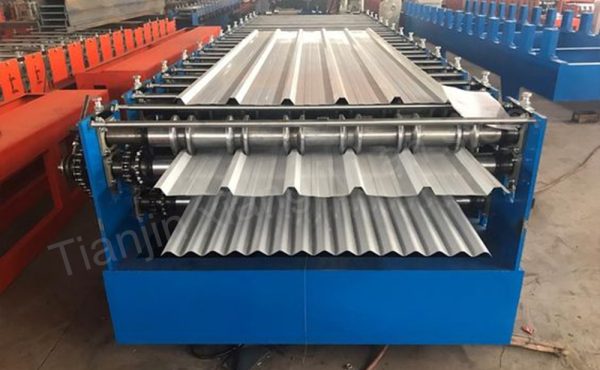 Steel plate tile forming processing technology refers to the use of mechanical equipment to process steel plates to give them a shape and structure similar to tiles. This processing process is often used to create roofing or wall covering materials that can replace traditional shingles or other roofing materials with greater durability and better waterproofing properties.
Steel plate tile forming processing technology refers to the use of mechanical equipment to process steel plates to give them a shape and structure similar to tiles. This processing process is often used to create roofing or wall covering materials that can replace traditional shingles or other roofing materials with greater durability and better waterproofing properties.
Processing steps:
Raw material preparation: Select appropriate steel plates as raw materials, usually color steel plates or galvanized steel plates with a certain thickness and strength.
Mold design: Design a suitable tile pressing mold, and determine the structure and parameters of the mold according to the required tile shape and size.
Steel plate pressing: Place the steel plate on the tile press, and press the steel plate through the action of the mold to form a tile-like structure.
Forming: The pressed steel plate is formed into a tile shape and can be further processed as needed, such as cutting, bending, etc.
Classification:
Corrugated tile: It is a common steel plate pressed tile product with a wavy surface and is suitable for building roof and wall coverings.
Glazed tile: It is processed by pressing steel plates to form an appearance and structure similar to traditional glazed tiles, with higher durability and waterproof performance.
Flat tiles: refer to steel plate tiles with flat surfaces, usually used for exterior wall decoration and decoration of buildings.
Vertical glazed tile: It is a vertically arranged steel plate tile with a unique decorative effect and is often used for building facade decoration.
use:
Building roofs: Steel plate pressed tile products are often used as covering materials for building roofs and have good waterproof, windproof and durability properties.
Wall decoration: Steel plate pressed tile products can also be used for decoration and decoration of building walls, increasing the aesthetics and decorative effect of the building.
Industrial buildings: Steel plate pressed tile products are suitable for covering roofs and walls of industrial plants, warehouses and other buildings, and have good corrosion resistance and weather resistance.
Agricultural buildings: Steel plate tile products are also commonly used in agricultural buildings, such as greenhouses, livestock houses, etc., and have good waterproof and thermal insulation properties.
Steel plate tile forming processing technology is a common steel processing method with various classifications and uses. We can provide you with corresponding processing services according to your specific needs.
Our Partners
We always adhere to the business philosophy of integrity and responsibility, aiming to bring high-quality and low-priced steel to our customers. You will not be disappointed if you choose us.


